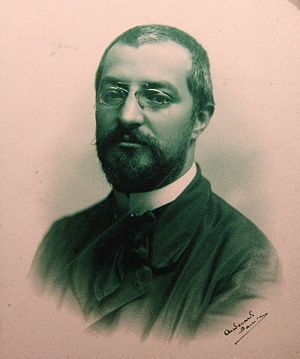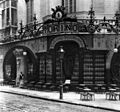Josep Puig i Cadafalch facts for kids
Josep Puig i Cadafalch (born in Mataró on October 17, 1867 – died in Barcelona on December 21, 1956) was a very important architect from Catalonia, Spain. He designed many famous buildings in Barcelona. He was also a politician who helped shape important Catalan organizations.
Puig i Cadafalch was known for his unique Modernista style. One of his most famous designs is the Casa Martí, also called "Els Quatre Gats". This building became a popular meeting spot for artists and thinkers like Santiago Rusiñol and Ramon Casas. He also designed the Casa Terrades, known as "les Punxes," which looks like a medieval castle from northern Europe.
Even though his style was different from his famous friend Gaudí, they worked together on projects like the Cafe Torino. Puig i Cadafalch was also active in politics. He was a city council member in Barcelona from 1901 to 1903. Later, he served in the Spanish Parliament. From 1917 to 1924, he was the second president of the Commonwealth of Catalonia. After 1942, he led the Institut d'Estudis Catalans, an important group for the Catalan language.
He cared deeply about Catalan culture and history. He wrote studies about the language and how society was organized in the 11th and 12th centuries. One of his big achievements was documenting and photographing important buildings and art in areas like the Vall d'Aran. This included the famous Catalan Romanesque Churches of the Vall de Boí. He did this during an expedition in 1907, supported by the Institute for Catalan Studies.
Contents
Amazing Buildings by Puig i Cadafalch
Josep Puig i Cadafalch designed many incredible buildings. Here are some of his most well-known works in different cities.
Buildings in Barcelona
Barcelona is home to many of Puig i Cadafalch's most famous designs.
- Casa Martí (1896): Located on Carrer Montsió, this building's ground floor housed "Els Quatre Gats." This was a popular meeting place for Modernista artists and writers. It's still in very good condition.
- Casa Amatller (1898–1900): Found on Passeig de Gràcia, this building was originally a house for a chocolate maker. Puig i Cadafalch gave it the look of an urban Gothic palace. Artists like Eusebi Arnau helped with the sculptures. It is in very good condition.
- Casa Macaya (1901): On Passeig de Sant Joan, this house has a white facade with cool graffiti. Its windows are decorated with sculptures by Eusebi Arnau. It's a beautiful urban home and is in very good condition.
- Cafè Torino (1902): This cafe on Passeig de Gràcia was a very stylish place. Even Antoni Gaudí helped decorate one of its rooms. It won an award from the Barcelona City Council. Sadly, it disappeared around 1910-1911.
- Casa Serra (1903): Located on Rambla de Catalunya, this building has a stone facade with beautiful decorations. The style is called Plateresque, and the sculptures were made by Eusebi Arnau. It is in very good condition.
- Palau del Baró de Quadras (1904–1906): This palace on Av. Diagonal was built for the Baron of Quadras. Today, it is the home of Casa Asia, an organization that promotes Asian culture. It is in very good condition.
- Casa Terrades (1905), also known as Casa de les Punxes: This apartment building on Av. Diagonal looks like a medieval castle with its pointed towers, which is why it's called "House of Spikes" (Punxes). It was designed for three sisters to live in and rent out parts of it. It is in very good condition.
- Fàbrica Casaramona (1911): This factory on Avinguda de Francesc Ferrer i Guàrdia was built for a textile business owner. It's a great example of industrial architecture. Today, it houses the CaixaForum Barcelona, a cultural center. It is in very good condition.
- Palau de la Generalitat de Catalunya (1914): Located in Plaça de Sant Jaume, Puig i Cadafalch helped restore this important building. It became a symbol of Catalan identity. He removed Spanish symbols and helped set up the National Library of Catalonia inside. It is in good condition.
- The Four Columns (1919): These four Ionic columns in Parc de Montjuïc were a symbol of Catalan identity. They represented the four red bars of the Catalan flag. They were torn down during a dictatorship but were rebuilt in 2010. They now stand as a symbol of Catalan culture and strength. They are in very good condition.
- Palaus d'Alfons XIII i de Victòria Eugènia (1920): These two palaces in Parc de Montjuïc were built for the 1929 Barcelona International Exposition. They are the only two palaces Puig i Cadafalch designed for the exhibition complex. They are in good condition.
- Casa Puig i Cadafalch (1917): This was his own private home on Carrer de Provença. It's a simpler building from his later "yellow period," where he focused on more urban housing styles. He lived here until he passed away in 1956. It is in very good condition.
Works in Other Towns
Puig i Cadafalch's work can be found in many other places in Catalonia.
- Església de Sant Esteve (1940) in Andorra la Vella: He helped rebuild parts of this old Romanesque church, including the upper floor of the tower. It is in good condition.
- Casa Puig i Cadafalch (1897–1905) in Argentona: This was his summer house, created by combining three buildings. It has a medieval feel with Modernista details. It is in regular condition.
- Casa Garí (1898) in Argentona: He transformed this manor house into a grand palace, showing off the latest artistic styles of the time. It is in very good condition.
- Pantheon Garí (1904) in Esplugues de Llobregat: This monument in the cemetery was built for the Garí family. It features a column with a wrought iron cross and sculptures. It is in regular condition.
- Creu de Terme, oratori i reformes (1898) in Lloret de Mar: Puig i Cadafalch directed the renovation of the Sant Pere del Bosc shrine. He designed access roads, an oratory, and a cross with a sculpture of Saint George. These are in good condition.
- Palau del Baró de Quadras (1900) in Massanes: This large neo-Gothic house was built for the Baron of Quadras. It has a square design with towers and battlements. It is in good condition.
- Casa Sisternes (1891) in Mataró: This is considered his very first work. It shows his early style with decorative lines of wrought iron, brick, and tile. It is in bad condition.
- Casa Coll i Regàs (1897) in Mataró: This private house combines sculptures by Eusebi Arnau with sgraffitos, tiles, and stained glass windows. It is in very good condition.
- Santa Maria de Montserrat (1925–1928) in Monistrol de Montserrat: He worked on restoring and expanding parts of this famous monastery, including the neo-Romanesque cloister and the Plaça de Santa Maria. It is in good condition.
- Monestir de Sant Benet de Bages (1907) in Sant Fruitós de Bages: Puig i Cadafalch restored this monastery for his friend, the owner Ramon Casas. It is in very good condition.
- Caves Codorniu (1895–1920) in Sant Sadurní d'Anoia: This is a large industrial complex for the Codorníu Winery. Puig i Cadafalch found clever solutions for each building's purpose. It is in very good condition.
- Granja Terrades (1904) in Seva: This Modernista house was built next to an old 12th-century farmhouse. It is in very good condition.
Images for kids
See also
 In Spanish: Josep Puig i Cadafalch para niños
In Spanish: Josep Puig i Cadafalch para niños




























































